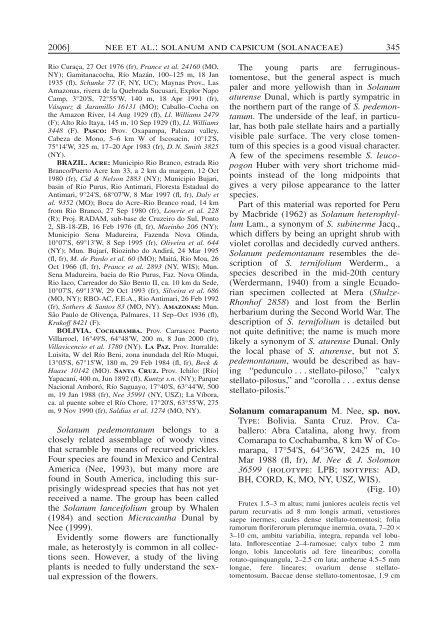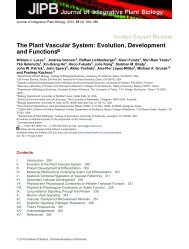New species of Solanum and Capsicum (Solanaceae) from Bolivia ...
New species of Solanum and Capsicum (Solanaceae) from Bolivia ...
New species of Solanum and Capsicum (Solanaceae) from Bolivia ...
Create successful ePaper yourself
Turn your PDF publications into a flip-book with our unique Google optimized e-Paper software.
2006] nee et al.: solanum <strong>and</strong> capsicum (solanaceae) 345<br />
Rio Curaça, 27 Oct 1976 (fr), Prance et al. 24160 (MO,<br />
NY); Gamitanacocha, Río Mazán, 100–125 m, 18 Jan<br />
1935 (fl), Schunke 77 (F, NY, UC); Maynas Prov., Las<br />
Amazonas, rivera de la Quebrada Sucusari, Explor Napo<br />
Camp, 3°20'S, 72°55'W, 140 m, 18 Apr 1991 (fr),<br />
Vásquez & Jaramillo 16131 (MO); Caballo–Cocha on<br />
the Amazon River, 14 Aug 1929 (fl), Ll. Williams 2479<br />
(F); Alto Río Itaya, 145 m, 10 Sep 1929 (fl), Ll. Williams<br />
3448 (F). Pasco: Prov. Oxapampa, Palcazu valley,<br />
Cabeza de Mono, 5–6 km W <strong>of</strong> Iscosacin, 10°12'S,<br />
75°14'W, 325 m, 17–20 Apr 1983 (fr), D. N. Smith 3825<br />
(NY).<br />
BRAZIL. Acre: Municipio Rio Branco, estrada Rio<br />
Branco/Puerto Acre km 33, a 2 km da margem, 12 Oct<br />
1980 (fr), Cid & Nelson 2883 (NY); Municipio Bujari,<br />
basin <strong>of</strong> Rio Purus, Rio Antimari, Floresta Estadual do<br />
Antimari, 9°24'S, 68°07'W, 8 Mar 1997 (fl, fr), Daly et<br />
al. 9352 (MO); Boca do Acre–Rio Branco road, 14 km<br />
<strong>from</strong> Rio Branco, 27 Sep 1980 (fr), Lowrie et al. 228<br />
(R); Proj. RADAM, sub-base de Cruzeiro do Sul, Ponto<br />
2, SB-18-ZB, 16 Feb 1976 (fl, fr), Marinho 206 (NY);<br />
Municipio Sena Madureira, Fazenda Nova Olinda,<br />
10°07'S, 69°13'W, 8 Sep 1995 (fr), Oliveira et al. 644<br />
(NY); Mun. Bujarí, Riozinho do Andirá, 24 Mar 1995<br />
(fl, fr), M. de Pardo et al. 60 (MO); Maitá, Rio Moa, 26<br />
Oct 1966 (fl, fr), Prance et al. 2893 (NY, WIS); Mun.<br />
Sena Madureira, bacia do Rio Purus, Faz. Nova Olinda,<br />
Rio Iaco, Carreador do São Bento II, ca. 10 km da Sede,<br />
10°07'S, 69°13'W, 29 Oct 1993 (fr), Silveira et al. 686<br />
(MO, NY); RBO-AC, F.E.A., Rio Antimari, 26 Feb 1992<br />
(fr), Sothers & Santos 83 (MO, NY). Amazonas: Mun.<br />
São Paulo de Olivença, Palmares, 11 Sep–Oct 1936 (fl),<br />
Kruk<strong>of</strong>f 8421 (F).<br />
BOLIVIA. Cochabamba. Prov. Carrasco: Puerto<br />
Villarroel, 16°49'S, 64°48'W, 200 m, 8 Jun 2000 (fr),<br />
Villavicencio et al. 1780 (NY). La Paz. Prov. Iturralde:<br />
Luisita, W del Río Beni, zona inundada del Río Muqui,<br />
13°05'S, 67°15'W, 180 m, 29 Feb 1984 (fl, fr), Beck &<br />
Haase 10142 (MO). Santa Cruz. Prov. Ichilo: [Río]<br />
Yapacaní, 400 m, Jun 1892 (fl), Kuntze s.n. (NY); Parque<br />
Nacional Amboró, Río Saguayo, 17°40'S, 63°44'W, 500<br />
m, 19 Jan 1988 (fr), Nee 35991 (NY, USZ); La Víbora,<br />
ca. al puente sobre el Río Chore, 17°20'S, 63°55'W, 275<br />
m, 9 Nov 1990 (fr), Saldias et al. 1274 (MO, NY).<br />
<strong>Solanum</strong> pedemontanum belongs to a<br />
closely related assemblage <strong>of</strong> woody vines<br />
that scramble by means <strong>of</strong> recurved prickles.<br />
Four <strong>species</strong> are found in Mexico <strong>and</strong> Central<br />
America (Nee, 1993), but many more are<br />
found in South America, including this surprisingly<br />
widespread <strong>species</strong> that has not yet<br />
received a name. The group has been called<br />
the <strong>Solanum</strong> lanceifolium group by Whalen<br />
(1984) <strong>and</strong> section Micracantha Dunal by<br />
Nee (1999).<br />
Evidently some flowers are functionally<br />
male, as heterostyly is common in all collections<br />
seen. However, a study <strong>of</strong> the living<br />
plants is needed to fully underst<strong>and</strong> the sexual<br />
expression <strong>of</strong> the flowers.<br />
The young parts are ferruginoustomentose,<br />
but the general aspect is much<br />
paler <strong>and</strong> more yellowish than in <strong>Solanum</strong><br />
aturense Dunal, which is partly sympatric in<br />
the northern part <strong>of</strong> the range <strong>of</strong> S. pedemontanum.<br />
The underside <strong>of</strong> the leaf, in particular,<br />
has both pale stellate hairs <strong>and</strong> a partially<br />
visible pale surface. The very close tomentum<br />
<strong>of</strong> this <strong>species</strong> is a good visual character.<br />
A few <strong>of</strong> the specimens resemble S. leucopogon<br />
Huber with very short trichome midpoints<br />
instead <strong>of</strong> the long midpoints that<br />
gives a very pilose appearance to the latter<br />
<strong>species</strong>.<br />
Part <strong>of</strong> this material was reported for Peru<br />
by Macbride (1962) as <strong>Solanum</strong> heterophyllum<br />
Lam., a synonym <strong>of</strong> S. subinerme Jacq.,<br />
which differs by being an upright shrub with<br />
violet corollas <strong>and</strong> decidedly curved anthers.<br />
<strong>Solanum</strong> pedemontanum resembles the description<br />
<strong>of</strong> S. ternifolium Werderm., a<br />
<strong>species</strong> described in the mid-20th century<br />
(Werdermann, 1940) <strong>from</strong> a single Ecuadorian<br />
specimen collected at Mera (Shulze-<br />
Rhonh<strong>of</strong> 2858) <strong>and</strong> lost <strong>from</strong> the Berlin<br />
herbarium during the Second World War. The<br />
description <strong>of</strong> S. ternifolium is detailed but<br />
not quite definitive; the name is much more<br />
likely a synonym <strong>of</strong> S. aturense Dunal. Only<br />
the local phase <strong>of</strong> S. aturense, but not S.<br />
pedemontanum, would be described as having<br />
“pedunculo . . . stellato-piloso,” “calyx<br />
stellato-pilosus,” <strong>and</strong> “corolla . . . extus dense<br />
stellato-pilosis.”<br />
<strong>Solanum</strong> comarapanum M. Nee, sp. nov.<br />
Type: <strong>Bolivia</strong>. Santa Cruz. Prov. Caballero:<br />
Abra Catalina, along hwy. <strong>from</strong><br />
Comarapa to Cochabamba, 8 km W <strong>of</strong> Comarapa,<br />
17°54'S, 64°36'W, 2425 m, 10<br />
Mar 1988 (fl, fr), M. Nee & J. Solomon<br />
36599 (holotype: LPB; isotypes: AD,<br />
BH, CORD, K, MO, NY, USZ, WIS).<br />
(Fig. 10)<br />
Frutex 1.5–3 m altus; rami juniores aculeis rectis vel<br />
parum recurvatis ad 8 mm longis armati, vetustiores<br />
saepe inermes; caules dense stellato-tomentosi; folia<br />
ramorum floriferorum plerumque inermia, ovata, 7–20 ×<br />
3–10 cm, ambitu variabilia, integra, rep<strong>and</strong>a vel lobulata.<br />
Inflorescentiae 2–4-ramosae; calyx tubo 2 mm<br />
longo, lobis lanceolatis ad fere linearibus; corolla<br />
rotato-quinquangula, 2–2.5 cm lata; antherae 4.5–5 mm<br />
longae, fere lineares; ovarium dense stellatotomentosum.<br />
Baccae dense stellato-tomentosae, 1.9 cm
















